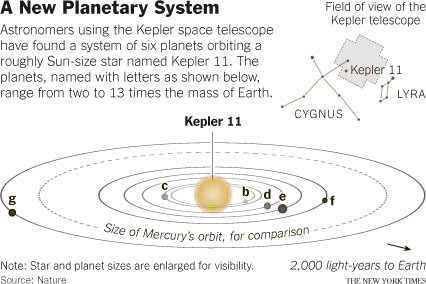 Feb 2, 2011: Astronomers have cracked the Milky Way like a piñata, and planets are now pouring out so fast that they do not know what to do with them all.
Feb 2, 2011: Astronomers have cracked the Milky Way like a piñata, and planets are now pouring out so fast that they do not know what to do with them all.
In a long-awaited announcement, scientists operating NASA’s Kepler planet-hunting satellite reported on Wednesday that they had identified 1,235 possible planets orbiting other stars, potentially tripling the number of known planets.
Of the new candidates, 68 are one and a quarter times the size of the Earth or smaller — smaller, that is, than any previously discovered planets outside the solar system, which are known as exoplanets. Fifty-four of the possible exoplanets are in the so-called habitable zones of stars dimmer and cooler than the Sun, where temperatures should be moderate enough for liquid water.
Astronomers said that it would take years to confirm that all of these candidates were really planets — by using ground-based telescopes to measure their masses, for example, or inspecting them to see if background stars are causing optical mischief. Many of them might never be vetted because of the dimness of their stars and the lack of telescope time and astronomers to do it all. But statistical tests of a sample suggest that 80 to 95 percent of the objects on it are real, as opposed to blips in the data.
“It boggles the mind,” said the Kepler team’s leader, William Borucki, of the Ames Research Center in Northern California.
At first glance, not one of them appears to be another Earth, the kind of cosmic Eden fit for life as we know it, but the new results represent only four months’ worth of data on a three-and-a-half-year project, and have left astronomers optimistic that they will eventually find Earth-like planets.
“For the first time in human history, we have a pool of potentially rocky habitable-zone planets,” said Sara Seager of the Massachusetts Institute of Technology, who works with Kepler. “This is the first big step forward to answering the ancient question, ‘How common are other Earths?’ ”
At a news conference at NASA headquarters in Washington on Wednesday, Mr. Borucki noted that the Kepler telescope surveys only one four-hundredth of the sky. If it could see the whole sky, he said, “we would see 400,000 candidates.” He is the lead author of a paper describing the new results that has been submitted to The Astrophysical Journal.
In a separate announcement, to be published in the journal Nature on Thursday, a group of Kepler astronomers led by Jack Lissauer of Ames said it had found a star with six planets — the most Kepler has yet discovered around one star — orbiting in close ranks in the same plane, no farther from their star than Mercury is from the Sun.
This dense packing, Dr. Lissauer said, seems to violate all the rules astronomers have begun to discern about how planetary systems form and evolve.
“This is sending me back to the drawing board,” he said.
Summarizing the news from the cosmos, Geoffrey W. Marcy of the University of California, Berkeley, a veteran exoplanet hunter and a mainstay of the Kepler work, said, “There are so many messages here that it’s hard to know where to begin.”
He called the Borucki team’s announcement “an extraordinary planet windfall, a moment that will be written in textbooks. It will be thought of as watershed.”
Debra Fischer, an astronomer at Yale who is not part of the Kepler team, said, “This is an amazing era of discovery for astronomy.” Kepler, she added, had “blown the lid off everything we thought we knew about exoplanets.”
Kepler, launched into orbit around the Sun in March 2009, stares at a patch of the Milky Way near the Northern Cross, measuring the brightness of 156,000 stars every 30 minutes, looking for a pattern of dips that would be caused by planets crossing in front of their suns.
The goal is to assess the frequency of Earth-like planets around Sun-like stars. But in the four months of data analyzed so far, a similar telescope looking at our own Sun would have been lucky to have seen the Earth pass even once. Three transits are required for a planet to show up in Kepler’s elaborate data-processing pipeline, which means that Kepler’s next scheduled data release, in June 2012, could be a moment of truth for the mission.
For dimmer and cooler stars, the habitable, or “Goldilocks,” zone, would be smaller, however, and planets in it would rack up transits more quickly.
Scientists had eagerly anticipated Wednesday’s data release since June, when Kepler scientists issued their first list of some 300 stars that were suspected of harboring planets but held back another 400 for study. In the intervening months, Mr. Borucki said, some of those candidates have been eliminated, but hundreds more have been added that would otherwise have been reported in June.
One of the 400 was a Sun-like star about 2,000 light-years from Earth in the constellation Cygnus that went by the name of KOI 157, for Kepler Object of Interest. In the spring of 2009, astronomers noticed that it seemed to have five candidate planets, four with nearly the same orbital periods, and in the same plane, like an old vinyl record, Dr. Lissauer said. Two of them came so close that every 50 days one of them would look as large as a full moon as seen from the other, Dr. Lissauer calculated.
“I got very interested in this system,” Dr. Lissauer said. “Five was the most we had around any target.” Moreover, the planets’ proximity to one another meant that they would interact gravitationally, allowing them to be weighed. In the fall, a sixth planet — the innermost — was found.
By measuring the slight variations in transit times caused by the gravitational interference of the inner five planets with one another, Dr. Lissauer and his colleagues were able to calculate their masses and densities. These measurements confirmed they were so-called super-Earths, with masses ranging from 2 to 13 times that of the Earth. But they were also puffy, probably containing mixtures of rock, water and gas, rather than being pure rock like another super-Earth, Kepler 10b, a hunk of lava whose existence was announced last month at a meeting in Seattle. Dr. Lissauer described them as “sort of like marshmallows with a little hard-candy core.”
As a result, Dr. Lissauer said, “super-Earths might not resemble Earth at all. They may be more like Neptune than Earth-like.”
Alan Boss, a planetary theorist at the Carnegie Institution of Washington, said the Kepler 11 system, as it is now known, should “keep theorists busy and off the streets for a long time.”
Mr. Borucki said the growing number of small planets revealed by Kepler was a welcome change from the early days of exoplanet research, when most of the planets discovered were Jupiter-size giants hugging their stars in close orbits, leading theorists to speculate that smaller planets might be thrown outward from their stars by gravitational forces or dragged right into those suns.
“Those little guys are still there,” he said, “and we’re delighted to see them.”

